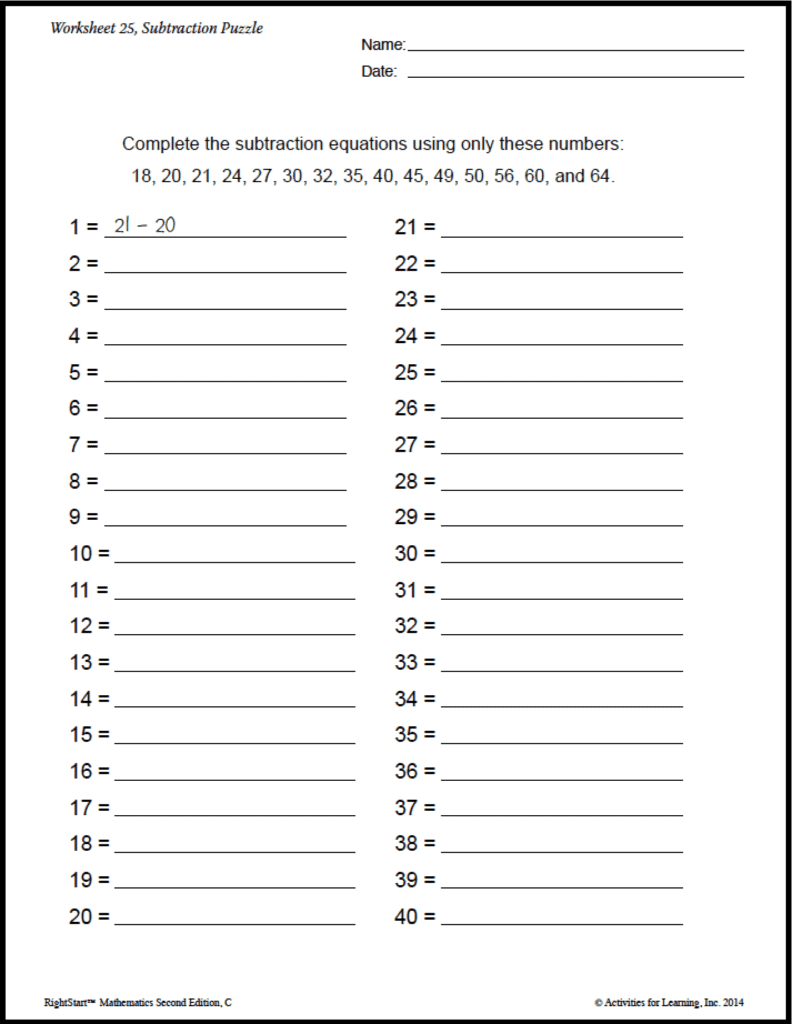In 2nd grade Lessons 53 and 54, students are asked to complete Worksheet 25 using specific numbers.

This worksheet is designed to be solved more like a puzzle than a worksheet. Here are some helpful strategies to help your students complete this worksheet without unnecessary stress.
The Groundwork
During the previous ten lessons, your students learned how to subtract. They studied subtraction math facts and learned a variety of subtraction strategies. This worksheet provides a unique way to practice those skills.
The Puzzle
For some students, the puzzle part of this worksheet is challenging. The struggle students have while completing this worksheet is that they are limited in the numbers they can use to solve the problems. For Worksheet 25, students can only use the following numbers in their solutions:
18, 20, 21, 24, 27, 30, 32, 35, 40, 45, 49, 50, 56, 60, and 64
The Process
It is essential to recognize that many problems can have several solutions. For example, for problem 5 = _______, students can solve the problems with 5 = 35 – 30 or 5 = 40 – 35.
Using Consecutive Numbers:
When looking at each problem, students can look at the numbers immediately next to each other, subtract them, and see where the solution might fit. For example, the student can use 20 and 18 to create this equation: 2 = 20 – 18.
Students can also look at every other number or every third number to get the solutions they need. For example, the numbers 21 and 18 can be used to create the equation 3 = 21 – 18, and the numbers 27 and 18 can be used to create the equation 9 = 27 – 18.
Using Addition:
Students can also consider using addition to solve the problems. Looking at the equation, 7 = _______ and the list of numbers available, have your students solve addition problems until they find one that fits.
7 + 18 (number in the list) = 25. Is 25 on the list? No, so move to the following number.
7 + 20 (number in the list) = 27. Is 27 on the list? Yes. Your student can use that combination on their worksheet: 7 = 27 – 20.
They can continue this strategy for other problems, as well.
Starting Backward:
Your student can also work backward using their subtraction skills.
Here is the list of numbers again for reference:
18, 20, 21, 24, 27, 30, 32, 35, 40, 45, 49, 50, 56, 60, and 64
Have your student start with 64 and subtract:
64 – 60 = 4 (They can put that in the “4 =” equation)
64 – 56 = 8 (They can put that in the “8 =” equation)
64 – 50 = 14 (they can put that one in the “14 =” equation), etc.
The Requirements
On the first day, you will work through Lesson 53, and your students will complete the first 10 problems. Then, the following day, you will work through Lesson 54, and the students will solve the remaining problems. Therefore, students have more than one day to finish this worksheet.
You can help your students learn to use the previously described strategies to solve the problems on Worksheet 25. You might even have them work in small groups and learn from each other.
Worksheet 25 encourages your students to try new processes, apply common sense, and demonstrate an understanding of the relationship between addition and subtraction.
The Conclusion
Yes, some students find this worksheet frustrating or challenging. However, frustration is part of the learning process, and challenge develops perseverance. With your encouragement and the use of strategies, your students will grow in their critical thinking and problem-solving skills.
Do not hesitate to contact us if you have any questions about the RightStart Math curriculum or worksheets.
